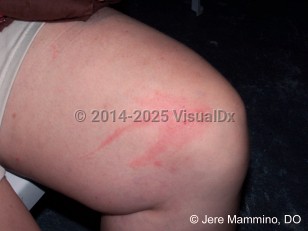Paederus dermatitis in Adult
Alerts and Notices
Important News & Links
Synopsis

Paederus dermatitis (PD), also known as dermatitis linearis, is a specific type of irritant contact dermatitis caused by exposure to pederin, a potent vesicant contained in the hemolymph of beetles of the genus Paederus. The condition is characterized by erythematous patches with vesiculobullous lesions that appear suddenly, often overnight, on exposed areas of skin and self-resolve over the course of 1-3 weeks.
The Paederus beetle does not sting or bite, but accidental contact with or crushing of the beetle on skin results in the release of the coelomic fluid containing the irritant pederin. Initially painless, over the course of 12-36 hours, the contact site begins to burn, sting, and itch.
Erythematous patches first appear and are followed by vesicles, which coalesce into bullae over the course of several days. Affected areas appear similar to chemical or thermal burns, but the clinical symptoms of burning and itching are relatively mild and disappear within a few days. The skin manifestations persist 1-3 weeks as vesicles, pustules, and bullae; lesions then crust, scale, and eventually desquamate without scarring. Postinflammatory hyperpigmented patches are transient but may last months. Atypical variants may present with more systemic skin involvement and symptoms of more severe burning and itching, fever, neuralgia, arthralgia, and vomiting.
PD size, shape, severity, and location are case dependent but typically involve exposed skin. Periorbital involvement is common, with unilateral periorbital edema and keratoconjuctivitis due to secondary transfer of the irritant from the hands to the face (referred to as Nairobi eye in East Africa).
Paederus beetle species are distributed worldwide, typically living in moist environments (eg, near lakes, marshes, and flood plains) and hot, tropical climates, scavenging debris and the larvae of other insects. While they are able to fly, they prefer to run, characteristically curling when disturbed. The beetles are 7-10 mm long, 0.5-1 mm wide, and are recognized by their distinct black head, red-orange abdomen, black posterior tip of abdomen, and metallic blue or green wings. Paederus beetles are nocturnal and are attracted to artificial lighting, particularly ultraviolet lights (eg, insect electrocution devices) and white lights (eg, fluorescent lights).
PD has a wake-and-see presentation, with beetle exposure occurring inadvertently overnight and skin manifestations appearing in the morning. Patients may not recall seeing any arthropods and will deny recent stings or bites. Incidence of PD is seasonal, with rates peaking during the spring and summer and dropping off significantly as ambient temperatures decrease during the fall. Risk factors include outdoor activities (eg, agriculture, gardening, or military patrols) and working at night in well-illuminated areas (eg, security guards). While the rapid appearance of vesicles and bullae can be concerning, PD often has a mild clinical course that self-resolves over several weeks. Early identification can prevent unnecessary diagnostic tests and treatments and help avoid further outbreaks.
The Paederus beetle does not sting or bite, but accidental contact with or crushing of the beetle on skin results in the release of the coelomic fluid containing the irritant pederin. Initially painless, over the course of 12-36 hours, the contact site begins to burn, sting, and itch.
Erythematous patches first appear and are followed by vesicles, which coalesce into bullae over the course of several days. Affected areas appear similar to chemical or thermal burns, but the clinical symptoms of burning and itching are relatively mild and disappear within a few days. The skin manifestations persist 1-3 weeks as vesicles, pustules, and bullae; lesions then crust, scale, and eventually desquamate without scarring. Postinflammatory hyperpigmented patches are transient but may last months. Atypical variants may present with more systemic skin involvement and symptoms of more severe burning and itching, fever, neuralgia, arthralgia, and vomiting.
PD size, shape, severity, and location are case dependent but typically involve exposed skin. Periorbital involvement is common, with unilateral periorbital edema and keratoconjuctivitis due to secondary transfer of the irritant from the hands to the face (referred to as Nairobi eye in East Africa).
Paederus beetle species are distributed worldwide, typically living in moist environments (eg, near lakes, marshes, and flood plains) and hot, tropical climates, scavenging debris and the larvae of other insects. While they are able to fly, they prefer to run, characteristically curling when disturbed. The beetles are 7-10 mm long, 0.5-1 mm wide, and are recognized by their distinct black head, red-orange abdomen, black posterior tip of abdomen, and metallic blue or green wings. Paederus beetles are nocturnal and are attracted to artificial lighting, particularly ultraviolet lights (eg, insect electrocution devices) and white lights (eg, fluorescent lights).
PD has a wake-and-see presentation, with beetle exposure occurring inadvertently overnight and skin manifestations appearing in the morning. Patients may not recall seeing any arthropods and will deny recent stings or bites. Incidence of PD is seasonal, with rates peaking during the spring and summer and dropping off significantly as ambient temperatures decrease during the fall. Risk factors include outdoor activities (eg, agriculture, gardening, or military patrols) and working at night in well-illuminated areas (eg, security guards). While the rapid appearance of vesicles and bullae can be concerning, PD often has a mild clinical course that self-resolves over several weeks. Early identification can prevent unnecessary diagnostic tests and treatments and help avoid further outbreaks.
Codes
ICD10CM:
L23.89 – Allergic contact dermatitis due to other agents
SNOMEDCT:
402149002 – Dermatosis due to beetle
L23.89 – Allergic contact dermatitis due to other agents
SNOMEDCT:
402149002 – Dermatosis due to beetle
Look For
Subscription Required
Diagnostic Pearls
Subscription Required
Differential Diagnosis & Pitfalls

To perform a comparison, select diagnoses from the classic differential
Subscription Required
Best Tests
Subscription Required
Management Pearls
Subscription Required
Therapy
Subscription Required
References
Subscription Required
Last Updated:07/10/2017
Paederus dermatitis in Adult

